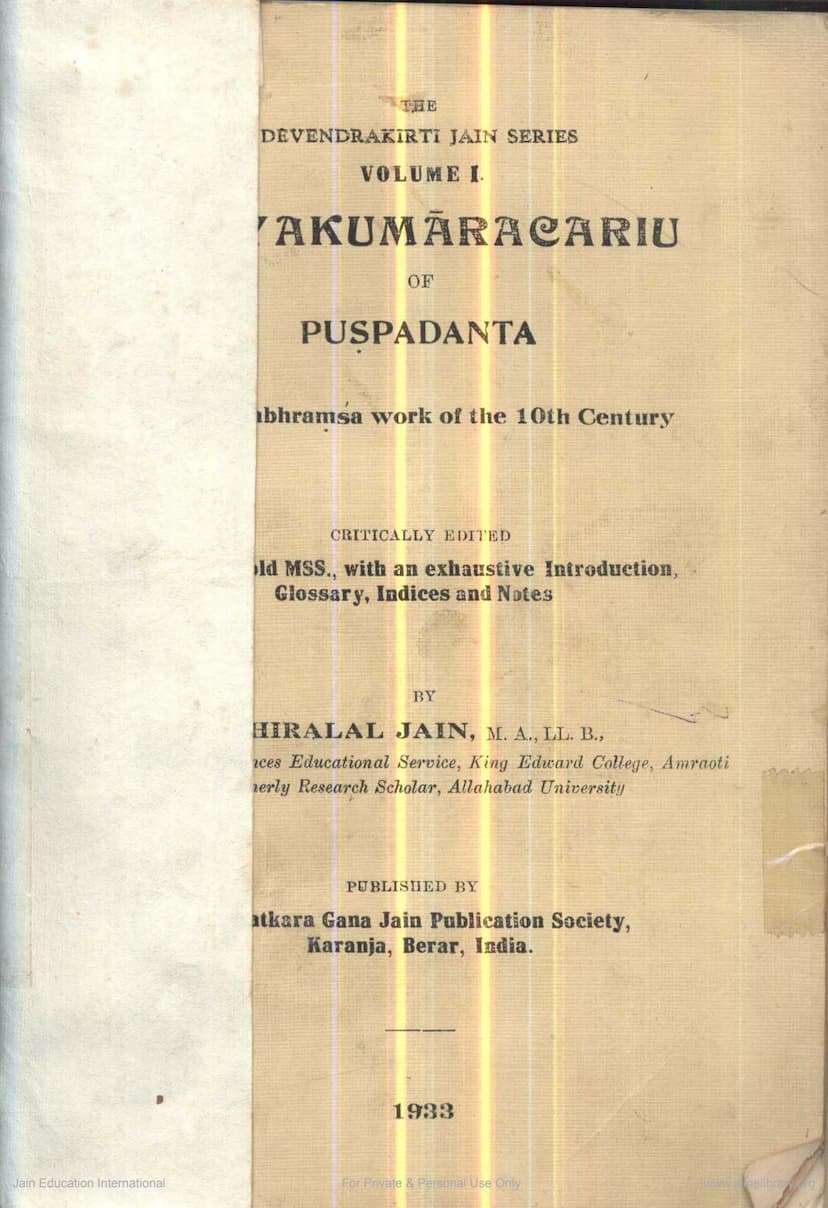Nayakumarchariu
Added to library: September 2, 2025

Summary
This document is the title page and index of the book Nāyakumāracariu of Puṣpadanta, critically edited by Hiralal Jain, M.A., LL.B. It was published in 1933 by the Balatkara Gana Jain Publication Society, Karanja, Berar, India. It is Volume I of the Devendrakirti Jain Series.
The work is an Apabhramśa text of the 10th Century, critically edited from old manuscripts with an exhaustive introduction, glossary, indices, and notes.
Here's a breakdown of the key information presented:
About the Book:
- Title: Nāyakumāracariu of Puṣpadanta
- Author: Puṣpadanta
- Editor: Hiralal Jain, M.A., LL.B.
- Publisher: Balatkara Gana Jain Publication Society, Karanja, Berar (India)
- Series: The Devendrakirti Jain Series, Volume I
- Date of Publication: 1933 (Vikram Samvat 1989, Vir Nirvana Samvat 2459)
- Language: Apabhramsa
- Century: 10th Century
Key Features of the Edition:
- Critical Edition: Based on multiple old manuscripts.
- Exhaustive Introduction: Covering various aspects of the work, including its language, metre, the poet and his patron, historical context, and analysis of the narrative.
- Glossary: Providing Sanskrit equivalents and explanations for Apabhramśa words.
- Indices: For personal names and geographical names.
- Notes: Critical and explanatory notes to aid understanding.
- Addenda et Corrigenda: Corrections and additions.
About the Poet and the Work:
- Poet: Puṣpadanta, a major Jain poet of the 10th century. He was a Brahmin of Kāśyapa gotra and patronized by ministers Bharata and Nanna of the Rastrakuta dynasty.
- Work: The Nāyakumāracariu narrates the story of Nāgakumāra, illustrating the fruit of observing the fast of Sri Pañcamī. It is divided into nine chapters (Sandhis) and contains 150 Kadavakas (metrical units) with a total of 2205 lines.
- Historical Context: The work provides insights into the political divisions of India in the 10th century, the literary center of Mānyakheta, and details of palace and public life, including marriage customs and fashion.
- Language and Metre: The Apabhramśa language used is discussed in detail, including its alphabet, morphology, verbs, and indeclinables. The work employs various metres, primarily Mātrā-vrtta.
- Popularity: The hero Nāgakumāra is recognized as one of the twenty-four Kamadevas in Jainism, and his story has been written by various authors in different languages.
The Introduction delves into several key areas:
- Critical Apparatus: Describes the five manuscripts used for the edition.
- Text Constitution: Outlines the principles followed in constituting the text.
- The Poet and His Patron: Provides biographical details about Puṣpadanta and his patrons, Bharata and Nanna.
- Mānyakheta a literary centre: Highlights the significance of Mānyakheta as a hub of literary activities during the Rāshtrakuta period.
- Popularity of the hero: Lists various authors and works that deal with the story of Nāgakumāra.
- The Poet's Education: Demonstrates Puṣpadanta's extensive knowledge of Hindu, Buddhist, and Jain scriptures, philosophy, mythology, and various technical branches of literature.
- Picture of Palace and Public life: Offers detailed descriptions of royal life, marriage customs, fine arts, amusements, military organization, trade, fashion, and popular beliefs.
- Political Divisions of India as found in Nāyakumāracariu: Lists the various kingdoms and their capitals mentioned in the text.
- The Nāgas and the Nāgaloka: Discusses the role of Nāgas in Indian folklore and literature, providing historical and epigraphical evidence for their existence as a distinct tribal entity. It also explores the possible identification of Nāgaloka with regions around present-day Nagpur.
- Analysis of the work: Provides a chapter-wise summary of the narrative.
- Language and Grammar: Detailed analysis of the Apabhramsa language used, including its alphabet, morphology, verbs, participles, and indeclinables.
- Metre: Discusses the various metres employed in the work, including Mātrā-vrtta and Varna-vrtta.
- The Gloss and its Authorship: Identifies Prabhācandra Paṇḍita as the author of the glosses found on the manuscripts.
The provided pages also contain the beginning of the Apabhramsa text itself, starting with an invocation to the goddess Sarasvatī and the initial request made to Puṣpadanta to compose the work. The text is presented with original Apabhramśa script and headlines.